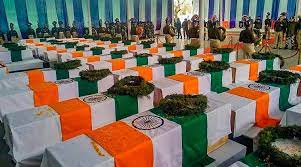Pulwama Terror Attack Unraveling the Impact and Aftermath
The date, February 14, holds a somber significance for India, marking the fifth anniversary of the Pulwama terror attack. This fateful day witnessed a devastating event that shook the nation to its core. The image of 40 coffins draped in the tricolor remains etched in the memory of every Indian. As the nation pays homage to its martyrs, it’s imperative to delve into the events that unfolded post the Pulwama attack.
Remembering the Sacrifice
Prime Minister Narendra Modi, in 2019, paid tribute to the martyred Central Reserve Police Force (CRPF) personnel who lost their lives in the terrorist attack. He emphasized that the service and sacrifice of these brave souls would always be remembered. The attack, orchestrated by Pakistan-backed terrorists, targeted a CRPF convoy, resulting in the martyrdom of 40 jawans. The nation mourned, and PM Modi led the country in honoring the fallen heroes.
Retaliation – Balakot Airstrike
In response to the Pulwama attack, the Indian Air Force conducted a surgical strike on February 26, 2019, targeting terrorist camps in Balakot, Pakistan. This marked a significant shift in India’s approach, showcasing a strong response to terrorism emanating from across the border. The events leading up to the Balakot airstrike were crucial in addressing the threats posed by militant groups.
Targeting the Mastermind
Lieutenant General KJS Dhillon, the Corps Commander, played a pivotal role in the counter-terrorism operations. Within a week of taking charge, Pulwama faced a tragic suicide bombing. Dhillon, determined to bring the perpetrators to justice, highlighted the need to end the reign of terror in the region. The focus shifted towards targeting the mastermind, identified as Ghazi, the Jaish-e-Mohammed commander responsible for orchestrating the Pulwama attack.
Underground Operations and Countermeasures
Dhillon stressed the importance of preventing terrorists from going underground. Continuous engagement and communication were essential for intercepting their activities. Security forces launched operations across various locations, targeting suspicious individuals and locations. The objective was clear – disrupt their plans and prevent another Pulwama-like catastrophe.
The Siege of Pinglan Village
In an intense 48-hour operation, security forces surrounded the village of Pinglan, where intelligence suggested the terrorists were hiding. Major Vibhuti Dhaundiyal, along with other brave soldiers, laid their lives in the line of duty during the mission. The challenge was magnified by the village’s geography, with makeshift and sturdy structures limiting the use of excessive force. However, the security forces maintained their resolve, ensuring that the module responsible for Pulwama was neutralized.
Foiling Pulwama 2.0
The terrorists, undeterred by the loss of their associates, continued plotting another attack similar to Pulwama. However, timely intelligence inputs allowed security forces to intervene, preventing a potential disaster. The vigilance displayed by the Indian armed forces and their unwavering commitment to national security successfully thwarted Pulwama 2.0.
Impact on Pakistan
Five years after the Pulwama attack, Pakistan finds itself isolated on the global stage. Economic challenges, political instability, and a lack of optimism among its citizens paint a grim picture. The international community acknowledges India’s stance on fostering peaceful relations with its neighbors while maintaining a strong and secure stance against terrorism.
The Pulwama terror attack left an indelible mark on India’s history, prompting a resolute response. The Balakot airstrike and subsequent counter-terrorism operations showcased India’s commitment to safeguarding its citizens. As the nation pays tribute to the martyrs, it is essential to reflect on the resilience displayed by the armed forces in the face of adversity
 Suspense Crime Sach Ka Dam
Suspense Crime Sach Ka Dam



